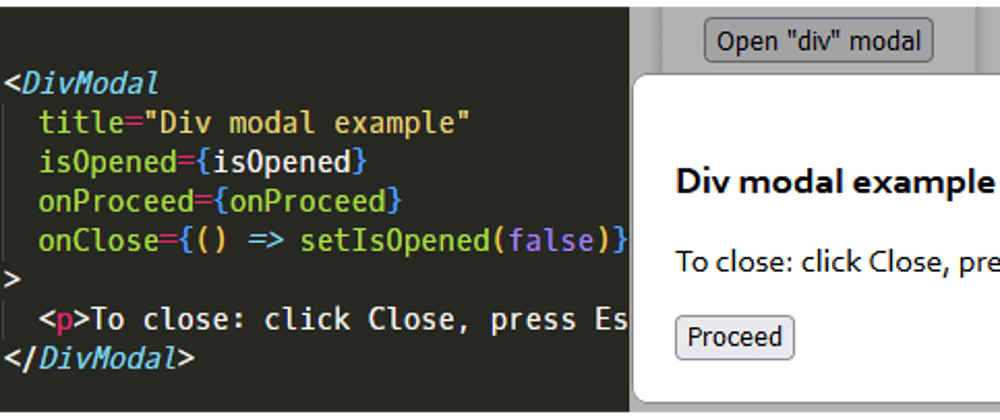The goal:
- Create a React modal dialog box using the html "div" element. Content provided as children. (Compare to: React modal using an html "dialog")
Notes:
- The "Modal" component is generic, it shows content from the parent container, provided as children.
- preventAutoClose() prevents closing when we click inside the modal dialog box.
I created two components:
First, the "DivModalTester" component contains and opens the modal:
import { useState } from "react";
// @ts-ignore
import { DivModal } from "components";
const DivModalTester = () => {
const [isOpened, setIsOpened] = useState(false);
const onProceed = () => {
console.log("Proceed clicked");
};
return (
<div>
<button onClick={() => setIsOpened(true)}>Open "div" modal</button>
<DivModal
title="Dialog modal example"
isOpened={isOpened}
onProceed={onProceed}
onClose={() => setIsOpened(false)}
>
<p>To close: click Close, press Escape, or click outside.</p>
</DivModal>
</div>
);
};
export default DivModalTester;
Secondly, the "DivModal" component itself:
import styled from "styled-components";
// @ts-ignore
import useKeyDown from "hooks/useKeyDown";
const Overlay = styled.div`
z-index: 1;
position: fixed;
top: 0;
left: 0;
width: 100%;
height: 100%;
background-color: rgba(0, 0, 0, 0.3);
`;
const Container = styled.div`
z-index: 2;
position: fixed;
top: 50%;
left: 50%;
transform: translate(-50%, -50%);
width: 400px;
border-radius: 8px;
border: 1px solid #888;
padding: 20px;
background-color: white;
`;
const Buttons = styled.div`
display: flex;
justify-content: space-between;
`;
type Props = {
title: string;
isOpened: boolean;
onProceed: () => void;
onClose: () => void;
children: React.ReactNode;
};
const DivModal = ({ title, isOpened, onProceed, onClose, children }: Props) => {
useKeyDown("Escape", onClose);
const proceedAndClose = () => {
onProceed();
onClose();
};
const preventAutoClose = (e: React.MouseEvent) => e.stopPropagation();
if (!isOpened) return null;
return (
<Overlay onClick={onClose}>
<Container onClick={preventAutoClose}>
<h3>{title}</h3>
{children}
<Buttons>
<button onClick={proceedAndClose}>Proceed</button>
<button onClick={onClose}>Close</button>
</Buttons>
</Container>
</Overlay>
);
};
export default DivModal;
Additionally, the modal component is using the useKeyDown() hook, to close the modal if the Escape gets pressed:
import { useEffect } from "react";
// Example 1 -- function as arg2:
// useKeyDown("Escape", onClose);
//
// Example 2 (if 1 does not work properly) -- function lambda as arg2:
// useKeyDown("ArrowRight", () => setPageIndex((prev: number) => f(prev, 1)));
// see: https://reactjs.org/docs/hooks-reference.html#functional-updates
const useKeyDown = (key: string, onKeyDown: () => void) => {
useEffect(() => {
const handleKeyDown = (event: KeyboardEvent) => {
if (event.key === key) onKeyDown();
};
window.addEventListener("keydown", handleKeyDown);
return () => {
window.removeEventListener("keydown", handleKeyDown);
};
// eslint-disable-next-line react-hooks/exhaustive-deps
}, []);
};
export default useKeyDown;
MY PERSONAL OPINION/PREFERENCE/RECOMMENDATION: I definitely prefer the React modal using the html "div", and not the one using the new html "dialog" element. I think a modal implemented using a "div" is: simpler, more intuitive, safer, and easier to maintain/troubleshoot.
Thanks for reading. Suggestions/corrections are welcome.







Top comments (0)